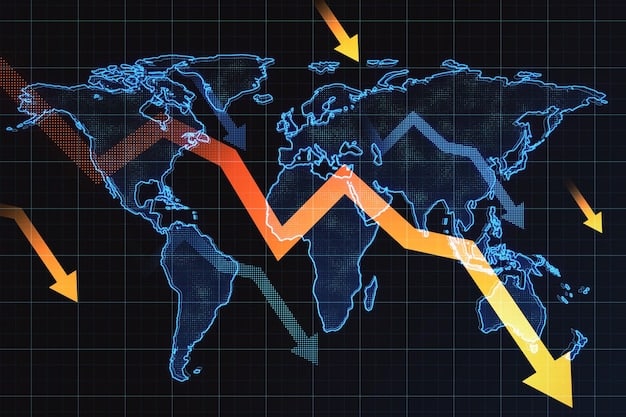Trade War Impact: Tariffs’ Effects on Business & Global Markets

Trade wars, characterized by tariffs and protectionist measures, significantly disrupt business operations and global markets by increasing costs, shifting supply chains, and fueling economic uncertainty, impacting everything from consumer prices to international relations.
The intricate web of global commerce is often influenced by geopolitical tensions, with trade wars emerging as a particularly disruptive force. Understanding the Trade War Impact: Analyzing the Effects of Tariffs on Business Operations and Global Markets is crucial for executives, policymakers, and consumers alike. These conflicts, typically marked by the imposition of tariffs, ripple through economies, reshaping supply chains, altering consumer behavior, and redefining international trade relationships. This article delves into the multifaceted consequences of such economic skirmishes, offering a comprehensive analysis of their profound effects.
The Fundamentals of Trade Wars and Tariffs
The concept of a trade war is not new, but its modern manifestations present unique challenges for an interconnected world. At its core, a trade war involves two or more countries imposing tariffs or other trade barriers on each other in retaliation for perceived unfair trade practices. This tit-for-tat exchange escalates, often leading to a reduction in international trade and economic friction.
Tariffs, which are essentially taxes on imported goods or services, serve as the primary weapon in a trade war. They can be specific, leisure-based, or ad valorem, calculated as a percentage of the value of the imported good. Governments typically impose tariffs to protect domestic industries, boost employment, or generate revenue. However, when used as a retaliatory measure, they can ignite a cycle of escalating trade tensions. The intended beneficiaries of tariffs, such as domestic producers, may initially gain an advantage, but the broader economic consequences can quickly outweigh these localized benefits. Understanding the historical context of trade disputes helps frame the current challenges.
Historical Precedents and Their Lessons
Trade disputes have been a recurring feature of global economic history, from the Smoot-Hawley Tariff Act of 1930 that arguably exacerbated the Great Depression to more recent spats between major economic powers. Each instance offers valuable lessons regarding the interconnectedness of economies and the potential for unintended consequences.
* 🇪🇺 The European Union and the United States have, at various points, engaged in disputes over agricultural subsidies and industrial tariffs.
* 🇨🇳 The United States and China have been at the forefront of recent trade tensions, with tariffs levied on hundreds of billions of dollars worth of goods.
* 🇯🇵 Japan and South Korea have seen trade relations strained by political disputes, leading to export controls on critical materials.
The lessons from these historical precedents are clear: while tariffs can offer short-term protection for specific industries, their long-term effects often include higher consumer prices, reduced competitiveness, and global economic slowdowns. The complexities of global supply chains mean that tariffs rarely impact isolated sectors in a vacuum; instead, they propagate throughout the entire economic ecosystem.
In many ways, the global economy has evolved significantly, making trade wars more impactful than ever. The intricate web of supply chains, where a single product might cross multiple borders during its manufacturing process, means that tariffs imposed at one stage can have cascading effects, increasing costs for producers and consumers downstream. It’s no longer a simple case of country A taxing imports from country B; rather, it’s country A taxing components that are essential for its own domestic industries, imported from country B, which then impacts the final price of manufactured goods sold back to country B and elsewhere.
Direct Impact on Business Operations
The imposition of tariffs introduces a myriad of challenges for businesses, fundamentally altering their operational landscape. From increased costs to restructured supply chains, the ripple effect is profound and far-reaching. Companies must adapt quickly, often at significant expense, to navigate this new terrain.
Increased Costs and Reduced Profit Margins
One of the most immediate effects of tariffs is an increase in the cost of imported goods, components, and raw materials. For businesses that rely on international supply chains, this translates directly into higher production costs. These costs can either be absorbed by the company, leading to reduced profit margins, or passed on to consumers, resulting in higher prices and potentially reduced demand. The delicate balance between profitability and market competitiveness is severely tested. Many businesses find themselves in a difficult position, forced to choose between eroding their bottom line or alienating their customer base. The long-term implications can be substantial, as sustained profit erosion can hinder innovation, investment, and growth.
Manufacturers across various sectors report significant financial strain. For instance, an appliance manufacturer sourcing steel from a country targeted by tariffs will face higher material costs. If they raise prices, they risk losing market share to competitors who may have diversified their sourcing or are not subject to the same tariff liabilities. Conversely, if they absorb the cost, their financial health deteriorates, potentially leading to layoffs or delayed expansion plans. This dilemma is a common thread running through industries affected by trade disputes.
Supply Chain Disruptions and Diversification
Trade wars compel businesses to re-evaluate and often restructure their existing supply chains. Relying heavily on suppliers from a country subject to tariffs becomes economically unfeasible. This leads to a scramble for alternative suppliers, often in new geographic locations, which introduces its own set of complexities and risks.
* Cost of Relocation: Shifting production facilities or finding new suppliers involves substantial upfront investments in research, negotiation, and logistics.
* Quality Control Risks: New suppliers may not meet the same quality standards or production capacities as established partners, leading to potential product defects or delays.
* Logistical Hurdles: Establishing new shipping routes and managing customs procedures in unfamiliar territories can create significant logistical bottlenecks.
One notable example is the electronics industry, which heavily relies on components manufactured globally. When tariffs are imposed, companies like Apple or Samsung face immense pressure to reconfigure their assembly lines and source parts from non-tariffed regions. This process is not only time-consuming and expensive but also fraught with risks related to quality and consistency. The drive for diversification, while a necessary response, also underlines the fragility of over-reliance on a single or limited set of suppliers. Companies are forced to invest in risk management strategies that were previously considered overly cautious, highlighting the paradigm shift in global sourcing.
Impact on Global Markets and Economic Growth
The ripple effect of trade wars extends far beyond individual businesses, significantly influencing global markets and overall economic growth. The interconnected nature of the modern economy means that protectionist measures in one region can trigger a cascade of negative consequences worldwide.
Reduced Global Trade Volumes
One of the most immediate and quantifiable impacts of trade wars is a contraction in global trade volumes. As tariffs make imports more expensive and less competitive, the flow of goods and services across borders naturally diminishes. This reduction in trade isn’t isolated to the countries directly engaged in the trade war; it affects all nations that are part of the global supply chain, leading to a worldwide slowdown in economic activity. The World Trade Organization (WTO) and various international financial institutions frequently downgrade their global growth forecasts during periods of heightened trade tensions, citing the dampening effect on commerce.
When trade volumes decline, it affects shipping companies, port operations, and logistics providers, leading to downstream job losses and reduced investment in infrastructure. Furthermore, countries that serve as intermediaries or re-exporters in global supply chains also suffer, even if they are not direct participants in the tariff dispute. The economic interdependence fostered over decades of globalization means that any significant disruption to trade routes or pricing structures has broad ramifications.
Increased Economic Uncertainty and Investor Caution
Trade wars breed economic uncertainty, which is perhaps their most corrosive effect on global markets. Businesses and investors thrive on predictability and stability. When trade policies are in flux, and the threat of new tariffs looms, decision-making becomes fraught with risk. This uncertainty discourages long-term investments, depresses stock markets, and leads to capital flight as investors seek safer havens.
The unpredictable nature of trade policy during a trade war makes it difficult for companies to plan future investments, product development, or expansion strategies. This hesitation can lead to a slowdown in innovation and job creation. Major investment decisions, such as building new factories or entering new markets, are often put on hold until the trade landscape becomes clearer. The lack of clarity around future trade relations creates a pervasive sense of caution that permeates financial markets and corporate boardrooms alike.
Disruption to Global Capital Flows
Trade wars can significantly disrupt global capital flows as investors react to increased geopolitical risk and economic uncertainty. Capital tends to flee markets perceived as unstable or vulnerable to trade pressures, often seeking refuge in traditionally safe assets like government bonds or currencies of stable economies. This reallocation of capital can lead to currency volatility in affected countries, making imports even more expensive or exports less competitive. Emerging markets, which are often more susceptible to external shocks, can be particularly vulnerable to significant capital outflows during periods of trade tension.
The shift in capital can also manifest in reduced foreign direct investment (FDI), as multinational corporations become hesitant to invest in countries with uncertain trade relationships. This not only impacts job creation but also limits the transfer of technology and expertise, hindering long-term economic development. For example, if a company is considering building a new manufacturing plant, the risk of future tariffs could sway them towards a location perceived as less politically sensitive, even if it is not the most economically efficient choice otherwise. This reevaluation often comes with substantial opportunity costs.

Sector-Specific Vulnerabilities and Resilience
While trade wars cast a wide net, certain sectors are demonstrably more vulnerable to their effects, while others demonstrate surprising resilience or even find opportunities amidst the disruption. Understanding these differential impacts is crucial for anticipating sector-specific challenges and devising targeted strategies.
Agriculture and Manufacturing: Frontline Industries
The agricultural sector, particularly in countries heavily reliant on exports, often finds itself on the frontline of trade wars. When tariffs are imposed on agricultural products, farmers can lose crucial export markets overnight, leading to surpluses, price drops, and financial distress. The perishable nature of many agricultural goods adds another layer of complexity, as unsold produce cannot simply be stored indefinitely. Government subsidies and aid packages are often necessary to cushion the blow, but these are often temporary fixes rather than long-term solutions.
Similarly, manufacturing industries, especially those with complex international supply chains or those producing goods with high trade volumes, are acutely vulnerable. Industries like automotive, electronics, steel, and textiles are frequently targeted because of their strategic importance or high value. Manufacturers face both increased input costs (due to tariffs on raw materials or components) and reduced demand for their finished products (due to retaliatory tariffs in export markets). The automotive industry, for example, often sources parts from multiple countries, making it highly susceptible to increased costs and logistical headaches when tariffs disrupt established supply lines.
Technology and Services: Adaptability and New Avenues
The technology sector, while not immune to the effects of tariffs on hardware components and supply chains, often displays greater adaptability. Software and services, for instance, are less directly impacted by cross-border tariffs on physical goods. However, trade wars can still affect the technology sector through export controls, restrictions on data flows, and increased scrutiny of foreign technology investments. Despite these challenges, the sector’s inherent dynamism and reliance on intellectual property often allow it to pivot more quickly, seeking out new markets or developing innovative solutions to bypass trade barriers.
The services sector, including financial services, tourism, and consulting, generally faces fewer direct tariff impacts compared to goods-producing sectors. However, indirectly, a slowdown in global economic growth due to trade wars can reduce demand for services, as businesses cut back on discretionary spending and consumers tighten their belts. Travel restrictions or political tensions stemming from trade disputes can also dampen tourism. Nevertheless, the services sector often possesses greater flexibility in shifting operations or client bases, making it somewhat more resilient than manufacturing or agriculture.
Strategies for Businesses to Mitigate Trade War Impacts
In the face of trade war uncertainty, businesses are not entirely powerless. Proactive and strategic planning can help mitigate some of the most severe impacts. Companies must adopt agile and resilient strategies to navigate the shifting landscape of global trade.
Diversifying Supply Chains and Markets
One of the most effective strategies is to diversify both supply chains and export markets. Over-reliance on a single country for raw materials, components, or as a primary market for finished goods significantly increases vulnerability during a trade war. By sourcing from multiple countries and exploring new markets, businesses can spread their risk and reduce exposure to specific tariffs or geopolitical tensions. This may involve:
- Exploring new suppliers in non-tariffed countries.
- Investing in domestic production capabilities to reduce import dependency.
- Identifying and developing new customer bases in unaffected regions.
While diversification involves upfront costs and logistical challenges, it builds long-term resilience. For instance, a footwear company that traditionally sourced all its leather from one nation might broaden its supplier base to several regions, reducing its exposure to any single trade dispute. This not only mitigates tariff risks but also enhances overall supply chain stability against other disruptions like natural disasters or political instability.
Lobbying, Advocacy, and Risk Management
Businesses can also engage in lobbying efforts and advocate for policies that minimize the negative effects of trade wars. Collective action through industry associations can increase their influence on government policy. Furthermore, robust risk management strategies are paramount. This involves:
- Conducting thorough scenario planning to assess potential tariff impacts.
- Implementing financial hedging strategies to mitigate currency fluctuations or commodity price volatility.
- Developing contingency plans for supply chain disruptions and market access changes.
- Engaging with legal and trade experts to understand complex tariff regulations and trade agreements.
Many large corporations employ dedicated trade policy teams that constantly monitor trade developments and advise on strategic responses. For smaller businesses, leveraging external consultants or industry bodies becomes even more critical. Proactive risk assessment and a clear understanding of potential future trade policy shifts allow companies to react more strategically rather than simply being reactive. The ability to forecast potential impacts and prepare for them can be a significant competitive advantage.
Government Responses and International Cooperation
Governments play a critical role in both initiating trade wars and mitigating their effects, often through a combination of domestic policies and international diplomatic efforts. Their actions can either exacerbate or alleviate the global economic fallout.
Domestic Support Measures and Subsidies
When domestic industries are hit hard by retaliatory tariffs, governments often step in with various support measures. These can include direct subsidies to farmers or manufacturers, tax breaks, low-interest loans, or investment in workforce retraining programs. The aim is to cushion the economic blow and prevent widespread job losses or bankruptcies. However, such measures can be costly to taxpayers and may contravene international trade rules, potentially leading to further disputes. For example, some governments have provided financial aid to agricultural sectors severely impacted by tariffs on key exports, attempting to stabilize the market and maintain farmer livelihoods.
While offering crucial short-term relief, critics argue that these subsidies can distort domestic markets and delay necessary structural adjustments. They can also create an uneven playing field for international competitors who do not receive similar support, leading to accusations of unfair trade practices. The efficacy of these measures is often debated, balancing immediate relief against long-term economic distortions. Moreover, the fiscal burden of sustained subsidies can be substantial, especially for large, export-oriented sectors.
The Role of International Trade Organizations
International organizations like the World Trade Organization (WTO) are designed to promote free trade and resolve trade disputes through established rules and a dispute settlement mechanism. During trade wars, their role becomes even more critical, acting as a forum for negotiation and mediation. However, the effectiveness of these organizations can be hampered if major economic powers choose to bypass or undermine their authority.
The WTO’s
role is to provide a framework for international trade negotiations and to ensure that member states adhere to international trade agreements. When disputes arise, member states can bring their cases to the WTO’s dispute settlement body, which issues rulings that are legally binding. While the WTO cannot force compliance, it can authorize retaliatory measures, encouraging adherence to its decisions. The challenge during trade wars is that some countries may prioritize national interests over multilateral rules, leading to a weakening of the international trading system as a whole. The future of the multilateral trading system depends heavily on renewed commitment from its largest members to uphold its principles and mechanisms.

The Geopolitical Ramifications of Trade Wars
Beyond mere economics, trade wars carry significant geopolitical weight, often reflecting and exacerbating broader international tensions. They aren’t just about goods and services; they’re about influence, power, and the shaping of the global order.
Shifting Alliances and Diplomatic Strain
Trade disputes can significantly strain diplomatic relations between countries, even among traditional allies. When nations perceive that their economic interests are being unfairly targeted, it can lead to a deterioration of trust and cooperation on other fronts, from security to climate change. Conversely, common grievances against a protectionist power can forge new, albeit sometimes temporary, alliances among affected nations who seek to present a united front.
The formation of new trading blocs or the strengthening of existing ones often accelerates during periods of trade friction. For example, countries impacted by tariffs from one major economy might seek to deepen trade ties with each other, creating alternative supply chains and markets that reduce their vulnerability to unilateral actions. This reshuffles the international power dynamic and can lead to a more fragmented global trading system, moving away from a truly multilateral approach. These shifts are not always smooth; they involve complex negotiations, differing national priorities, and the challenging task of building consensus.
Impact on Global Power Dynamics and Leadership
Trade wars can fundamentally alter global power dynamics. When a major economy uses tariffs as a tool of foreign policy, it signals a willingness to use economic leverage to achieve strategic objectives. This can challenge the established global leadership, with some nations seeing an opportunity to assert greater influence while others perceive a threat to their sovereignty. The credibility of international institutions and the rules-based global order can also be undermined if powerful nations disregard multilateral trade agreements in favor of unilateral actions.
The perception of economic strength directly translates into geopolitical influence. A country that consistently uses its economic might to impose its will on others can evoke both fear and resentment, potentially leading to a backlash. Over time, this can erode the soft power of a nation and encourage other countries to seek alternative leadership or build more resilient regional partnerships. The long-term consequence might be a more multipolar world, where economic power is distributed more widely, and no single nation can dictate global trade terms unchallenged. The strategic implications extend beyond economics, touching upon spheres of security, technology, and international diplomacy.
Long-Term Economic and Social Consequences
The protracted nature of trade wars means their effects are not merely immediate; they have deep and lasting economic and social consequences that can reshape societies and economies for years to come. These long-term impacts often unfold gradually, making them harder to attribute directly but no less significant.
Structural Economic Changes and De-globalization
One of the most profound long-term consequences is the potential for significant structural changes within national economies and a broader trend toward de-globalization. As businesses reshore production or divest from international supply chains to avoid tariffs, industries that once thrived on global trade may shrink, while domestic industries receive an artificial boost. This can lead to a less efficient allocation of resources globally, as countries produce goods they might otherwise import more cheaply. The pursuit of national self-sufficiency at the expense of global integration can lead to reduced overall economic efficiency and innovation.
Furthermore, a sustained period of trade protectionism can lead to a reversal of the decades-long trend of globalization. Companies may become more insular, focusing on domestic markets and supply chains. While this might offer some perceived national security benefits, it could also stifle cross-border innovation, limit access to diverse consumer markets, and ultimately reduce global economic growth. The intricate web of global interconnectedness, built over decades, can unravel, leading to a more fragmented and less prosperous world economy.
Innovation, Competitiveness, and Consumer Impact
Trade wars can have a chilling effect on innovation and long-term competitiveness. When companies are focused on navigating tariff barriers and adjusting supply chains, resources that would otherwise be allocated to research and development or technological advancement might be diverted. This can slow down the pace of innovation within affected industries. Moreover, artificially protecting domestic industries through tariffs can reduce their incentive to innovate and become more efficient, as they face less competition from foreign rivals. Over time, this can erode their international competitiveness.
For consumers, the long-term impact typically manifests as higher prices, reduced product variety, and potentially lower quality goods. While domestic industries might initially benefit from reduced foreign competition, the absence of competitive pressure can lead to less innovation and higher costs being passed on to the public. Consumers ultimately bear the brunt of trade wars through their wallets, as the cost of imported goods rises and domestic products may not offer the same value or choice. This can disproportionately affect lower-income households, increasing income inequality and potentially leading to social unrest if economic hardship becomes widespread.
| Key Point | Brief Description |
|---|---|
| 📈 Cost Increases | Tariffs hike import costs, leading to higher production expenses or consumer prices. |
| 🔗 Supply Chain Shifts | Businesses diversify suppliers and logistics to avoid tariffed regions. |
| 🌎 Global Trade Contraction | Overall international trade volumes decrease, affecting global GDP. |
| 🛡️ Geopolitical Strain | Trade wars worsen international diplomatic relations and shift alliances. |
Frequently Asked Questions about Trade War Impacts
A trade war is an economic conflict involving retaliatory actions like tariffs between two or more nations. It typically begins when one country imposes protectionist measures, leading others to respond in kind, escalating economic tensions and often reducing overall global trade volumes and market stability.
Tariffs can increase consumer prices by raising the cost of imported goods and components. This might lead to higher prices for both foreign and domestic products if companies pass on increased production costs. Additionally, consumers may experience reduced product variety and potentially lower quality options.
Yes, trade wars can lead to job losses, particularly in export-oriented industries affected by retaliatory tariffs and in sectors reliant on imported components that become more expensive. Businesses struggling with reduced demand or higher costs may downsize operations or freeze hiring, impacting unemployment rates.
Supply chains are critical in trade wars because tariffs on intermediate goods or raw materials can disrupt an entire production process. Companies are often forced to costly and time-consuming reconfigure global supply chains, seeking new suppliers to avoid tariffed regions, highlighting global economic interdependence.
Trade wars generally curb global economic growth by reducing overall trade volumes, discouraging investment due to increased uncertainty, and disrupting established economic efficiencies. This slowdown can cascade through interconnected economies, affecting GDP, employment, and market stability worldwide.
Conclusion
The ramifications of a trade war extend far beyond mere economic statistics, profoundly reshaping economies, businesses, and international relations. While tariffs are often initiated with the intent to protect domestic interests, their real-world impact is multifaceted, leading to increased costs, supply chain disruptions, and pervasive uncertainty for businesses. Globally, they contract trade volumes, dampen investment, and can trigger shifts in alliances, challenging the very fabric of the globalized world. Understanding these intricate dynamics is essential for navigating the complexities inherent in the modern economic landscape, as the ripple effects are felt from corporate boardrooms to consumer wallets, underscoring the critical need for thoughtful, collaborative approaches to international trade.





